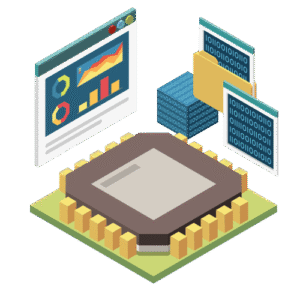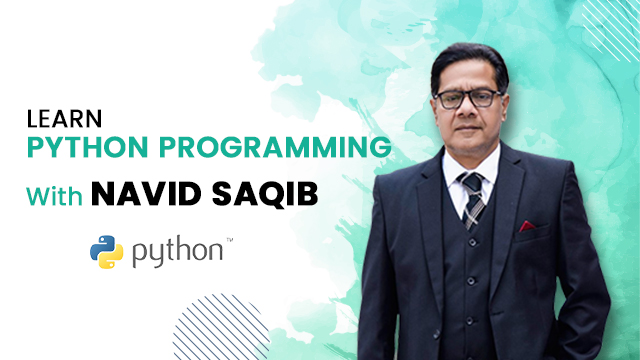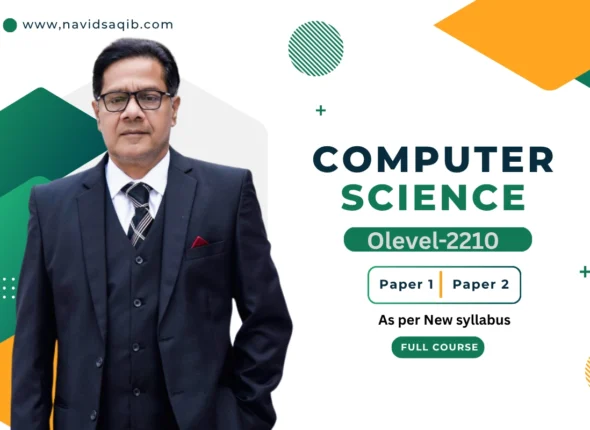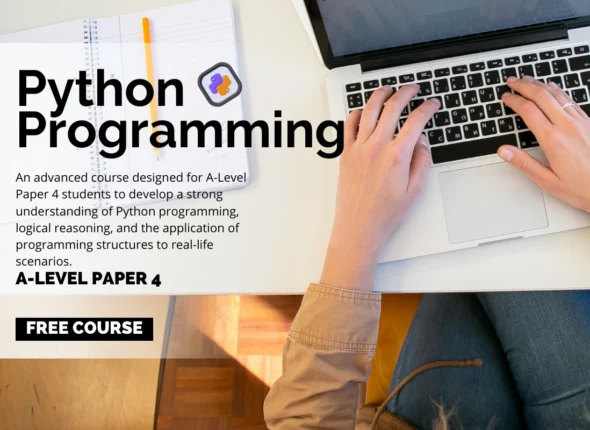
Computer Science 2210
Computer Science 2210 is an essential course for students pursuing a deeper understanding of computing principles, algorithms, and data structures.
This guide provides a comprehensive overview of the syllabus, key topics, study tips, and resources to help you excel in this course.



Student-Taught

Students








O Level Resources
All past papers available for download are the sole property of the University of Cambridge; no marks are assigned to them; the purpose is to assist students.
Notes:
Paper 1: Notes
computer science 2210 Paper 1 which contains 6 units to cover. if you are a student of IGCSE 0478, the same notes can be used for it as well. Download it Chapter by Chapter
Chapter1: Data Representation
Chapter2: Data Trasmission
Chapter3: Hardware & Computer Architecture
Chapter4: Software
Chapter5: Internet & its Usage
Chapter6: Automated * Emerging Technologies
Paper 2 :Notes
computer science 2210 Paper which contains 4 units to cover. if you are a student of IGCSE 0478, the same notes can be used for it as well. Paper 2 with Python- Visual basic based code, which contain 3 units to cover.
Chapter9 : Database
Chapter10: Boolean Logic
paper 2 visual Basic Notes Download
paper 2 Python Notes Download
Practice Questions
Paper 1 :Practice Material | Topic Wise | Online Practice
computer science 2210 Paper 1 which contains 6 units to cover. if you are a student of IGCSE 0478, the same notes can be used for it as well.
New updated Online Practice Material :
Chapter1 : Data Representation
Chapter2 : Data Trasmission
Chapter3 :Hardware
Chapter4 : Software
Chapter5 : Internet & its Usage
Chapter6 :Automated * Emerging Technologies
Paper2 :Practice Material | Questions & Worksheets
Here is the practice material, which consists of question sheets & work Sheets of paper 2.
Sheet 1 : Sample Questions-using IF THEN & LOOPS Download
Sheet 2 : Sample Questions-using IF THEN & LOOPS Download
Sheet 3 : Iteration sheet 1 Download
Sheet 4 : Iteration sheet 2 Download
Sheet 5 : Beginner level Arrays Sheet 1 Download
Sheet 6 : 1-D ARRAY QUESTIONS SHEET 2 Download
Sheet 7 : 2-D ARRAYS SHEET 1 Download
Sheet 8 : LINEAR SEARCH AND BUBBLE SORT-SHEET Download
Sheet 9 : Procedure-Function sheet1 Download
Sheet 10 : Procedure-Function sheet2 Download
Sheet 11 : Pseudocode practice Sheet (Python) Download
Sheet 12 : Pseudocode practice sheet (visual basic) Download
New updated Practice Material :
Extra Practice Questions: Online Practice (Topic wise Questions)
Syllabus & Resources
Syllabus & Speciman Papers
Updated Syllabus for CAIE Computer Science 2210 for year 2023 to 2025.
2210_y23-25_sy.pdf
Syllabus Change for CAIE Computer Science 2210 for year 2023 to 2025.
2210_y23-25_su.pdf
Speciman Paper for CAIE Computer Science 2210 paper 1 & 2 2023-A with Mark Schemes.
2210_y23_sp_1A.zip
Speciman Paper for CAIE Computer Science 2210 paper 1 & 2 2023 -B with Mark Schemes.
2210_y23_sp_1B.zip
Learning Resources
Far far away, behind the word mountains, far from the countries Vokalia and Consonantia, there live the blind texts. Separated they live in Bookmarksgrove right at the coast
2210 Teacher Guide ( 2023 Onwards).pdf
2210 Scheme of work ( 2023 Onwards).pdf
Further Resources
Pseudocode Guidelines Booklet
Pseudocode Booklet by cambrisge
pseudocode book for teachers, but students can use it to learn how to write pseudocode.
Pastpapers
Download Past Papers Pack
To download the complete set of olevel Computer Science 2210 Pastpapers, Markschemes, examiner report click here To DOWNLOAD Complete Set 2020 -2025
Disclaimer:
All pastpapers/documents available for download are the sole property of the University of Cambridge; no marks are assigned to them; the purpose is to assist students.

Top Categories
O-Level Computer Science/IGCSE
Business Management
0 CoursesArts & Design
0 CoursesPersonal Development
0 CoursesHealth & Fitness
0 CoursesData Science
0 CoursesMarketing
0 CoursesBusiness & Finance
0 CoursesComputer Science
0 CoursesVideo & Photography
0 CoursesPractice Pseudocode Like a Pro Use Pseudocode Editor

Get Started Now


Olevel : Computer Science 2210 : Full Course
- 126 Lessons
- 5 Students
Cambridge O-Level Computer Science 2210 The syllabus is divided into two papers:Paper 1 – Theory (Typically 2 hours)Paper 1 tests the...
Python Programming :Basic Course
- 54 Lessons
- 1 Students
Python Programming : Basic CourseO-Level 2210 students can learn this as basic-level programming.Introduction to PythonWhat is Python?Features and uses of...
Python programming : Advance Level 9618 P4
- 60 Lessons
- 0 Students
Course Description Lorem ipsum dolor sit amet, consectetur adipiscing elit, sed do eiusmod tempor incididunt ut labore et dolore magna...
STUDENT ENROLLED
CLASS COMPLETED
SATISFACTION RATE
TOP INSTRUCTORS
My Students Say
Read what my student`s has to say about me.

"Sir Navid Saqib’s mentorship went beyond teaching—his guidance, passion, and real-world insights truly shaped my professional journey."
- Arsalan Arshad -
Google Netherland
"Sir Navid Saqib’s unique teaching style, deep knowledge, and inspiring personality made learning unforgettable. I'm truly grateful to have been his student."
- Muneera Batool -
ASSISTANT PROFESSOR, COMMUNICATION & DESIGN Habib University | Batch 2002-2004
"Sir Navid Saqib’s passion and teaching style made learning ICT a joy. His clear explanations and lasting impact continue to guide me professionally. A truly outstanding teacher. May Allah bless him. Ameen."
- Zurnoob Shabbir -
Captain at Cape Air. Batch: 2010 2012
"Sir Navid Saqib is the finest teacher I’ve ever had. His fun, concept-based teaching made learning easy, and his generosity—especially during my tough times—was truly inspiring."
- Moeed Afzal –
Founding Software Engineer at SudoStudy. Batch: 2015-2017
"Studying under Sir Navid Saqib during my O & A Levels was a game-changer. His interactive and engaging teaching made learning Computer Science both enjoyable and impactful."
- Dawood Maqbool -
Full Stack Developer at US-based virtual Force Inc. batch 2015-2017
"Mr. Navid Saqib is an outstanding ICT teacher whose clear instruction and dedication helped me master the subject and reach my goals. I'm truly grateful for his impact on my academic journey."
- Rehman Amin -
Pilot at FlyDubai | Batch : 2006-2010
"Learning computers with Sir Navid Saqib during my O-levels was an incredible experience. His interactive teaching and deep knowledge made complex topics easy and enjoyable. Highly recommended!"
- Rohma Arif -
In-Flight Service Director, Air Canada | Batch : 2009
"Sir Navid Saqib’s teaching sparked my passion for Computer Science and robotics, leading to research opportunities at top universities like Cambridge, CMU, and Michigan."
- Kaleb Bin Naveed -
PHD Student of AI & Robotics | University of Michigan | Batch 2015-2017



Mastering the O-Level CS 2210 Syllabus: A Comprehensive Guide
The Cambridge IGCSE Computer Science 2210 syllabus offers a comprehensive introduction to the fundamentals of computer science, designed to equip students with essential skills and knowledge. To excel in this course, it’s crucial to understand and cover all syllabus topics thoroughly.
Understanding the Syllabus Structure
The Computer Science 2210 syllabus is divided into two main sections:
1. Theory of Computer Science (Paper 1)
This section focuses on the theoretical aspects of computer science. It covers fundamental concepts, principles, and the underlying theories that form the basis of the subject.
Key Topics:
- Understanding hardware, software, and the integration of both.
- How data is represented and manipulated within a computer system.
- Basics of networking, including types of networks, protocols, and security measures.
- Exploring the structure and function of the internet, including web development and cybersecurity.
- Fundamentals of databases, including data modeling, SQL, and database management.
- Examining the impact of computer science on society, including privacy, intellectual property, and ethical computing.
2. Practical Problem-Solving and Programming (Paper 2)
This section assesses practical skills in problem-solving and programming. It emphasizes the application of theoretical knowledge to solve real-world problems using programming techniques.
Key Topics:
- Techniques for designing algorithms to solve specific problems.
- Understanding programming fundamentals, including variables, control structures, data structures, and syntax.
- Principles of software engineering, including testing, debugging, and documentation.
- Writing and testing programs to perform specific tasks or solve problems.
By understanding the structure and requirements of each section of the Computer Science 2210 syllabus, you can develop effective study strategies to excel in both theoretical and practical aspects of the subject.
Regular practice, a clear grasp of concepts, and hands-on problem-solving will be key to your success.
Section 1: Theory of Computer Science (Paper 1)
This section covers the theoretical aspects of computer science. Key topics include:
1: Data Representation
- Binary Systems: Binary systems form the foundation of computer operations. Understanding how computers use binary (0s and 1s) to process data is crucial. Each binary digit, or bit, represents an on or off state, which corresponds to the electrical signals in hardware.
- Hexadecimal Systems: Hexadecimal (base 16) is another numerical system frequently used in computing, especially for memory addresses and color codes in web design. It uses sixteen symbols: 0-9 and A-F.
- Data Conversion: Converting data between different numerical systems, such as binary to decimal or hexadecimal to binary, is essential for various computing tasks.
- Data Storage and Compression: Efficient data storage and compression techniques are vital to managing the limited storage capacity of computer systems. This includes understanding different file formats and compression algorithms.
2: Communication and Internet Technologies
- Network Topologies: Network topologies define the layout of a network and how different nodes are interconnected. Common topologies include bus, star, ring, and mesh.
- Protocols: Protocols are rules that govern data communication over networks. Examples include TCP/IP, HTTP, and FTP. These protocols ensure reliable and accurate data transfer.
- Data Transmission Methods: Different methods of data transmission, such as wired (Ethernet) and wireless (Wi-Fi, Bluetooth), are used based on the requirements of speed, distance, and reliability.
3: Hardware and Software
- Components of Computer Systems: A computer system comprises various hardware components like the CPU, memory, storage devices, and input/output devices. Understanding their functions and interactions is fundamental.
- Types of Software: Software can be categorized into system software (e.g., operating systems), application software (e.g., word processors), and utility software (e.g., antivirus programs).
- Operating Systems: Operating systems (OS) are crucial as they manage hardware resources and provide services for application software. Examples include Windows, macOS, Linux, and Android.
4: Security
- Data Integrity: Ensuring data integrity involves maintaining the accuracy and consistency of data over its lifecycle. Techniques include error checking and validation methods.
- Cybersecurity Threats and Solutions: Cybersecurity addresses various threats such as viruses, malware, and hacking. Solutions include firewalls, encryption, antivirus software, and intrusion detection systems.
5: Ethics
- Ethical Considerations in Computer Science: Ethical considerations involve the responsible use of technology, including issues like privacy, surveillance, and the digital divide.
- Intellectual Property: Understanding intellectual property (IP) rights is essential in the digital age. This includes copyrights, patents, trademarks, and software licenses.
This section provides a comprehensive overview of the theoretical aspects of computer science, equipping students with the fundamental knowledge necessary for more advanced study and application in the field.
Strategies for Mastery
- Create a Study Schedule: Designate specific times for studying each topic to maintain consistent and organized study sessions. This approach helps in balancing different subjects and ensures thorough coverage of all material.
- Use Visual Aids: Employ diagrams, flowcharts, and other visual tools to simplify and clarify complex concepts, such as network topologies and hardware components. Visual aids can make abstract ideas more tangible and easier to understand.
- Engage in Active Learning: Involve yourself in interactive activities such as discussions, forums, and study groups. Engaging with peers and participating in conversations about the material can reinforce your understanding and retention of the subject matter.
- Practice Past Papers: Regularly work through past exam papers to become familiar with the exam format and the types of questions that may appear. This practice helps in identifying key areas to focus on and improves your ability to handle similar questions in actual exams.
Section 2: Practical Problem-Solving and Programming (Paper 2)
This section focuses on practical skills in programming and problem-solving. Key topics include:
1: Algorithm Design and Problem-Solving
A: Pseudocode
Pseudocode is a way to design algorithms using simple, human-readable language. It allows you to outline the logic of a program without being concerned with the syntax of a specific programming language. Key points include:
- Structure: Pseudocode should be clear and structured, representing the logical flow of the algorithm.
- Readability: It should be easy to understand and follow, even for someone who may not be familiar with programming.
B: Flowcharts
Flowcharts are visual representations of algorithms, showing the flow of control through various steps. Key elements include:
- Start/End: Represented by oval shapes.
- Processes: Represented by rectangles, showing operations or actions.
- Decisions: Represented by diamonds, showing branching based on conditions.
- Arrows: Indicate the direction of flow between steps.
C: Problem-Solving Techniques
Techniques to effectively solve problems include:
- Divide and Conquer: Breaking down a problem into smaller, manageable parts.
- Algorithmic Thinking: Designing step-by-step solutions.
- Backtracking: Trying different solutions and reverting when encountering dead ends.
- Greedy Algorithms: Making the locally optimal choice at each step to find a global optimum.
2: Programming
A: Programming Concepts
Fundamental concepts include:
- Variables and Data Types: Understanding different types of data (integers, strings, Booleans) and how to use variables to store them.
- Control Structures: Including loops (for, while) and conditionals (if, else).
- Functions: Defining reusable blocks of code to perform specific tasks.
- Object-Oriented Programming (OOP): Concepts like classes, objects, inheritance, and encapsulation.
B: Writing and Debugging Programs
Writing programs involves:
- Code Writing: Creating source code in a chosen programming language.
- Debugging: Identifying and fixing errors or bugs. Techniques include using debuggers, print statements, and reviewing code logic.
- Testing: Ensuring the program works correctly under various scenarios.
C: Understanding and Using Data Structures
Data structures are ways to organize and manage data efficiently:
- Arrays: Collections of elements stored in contiguous memory locations.
- Linked Lists: Collections of nodes where each node points to the next.
- Stacks and Queues: Structures for managing data with specific access rules (LIFO for stacks, FIFO for queues).
- Trees and Graphs: Hierarchical structures for representing relationships and connections.
3: Databases
A: Database Concepts
Fundamental database concepts include:
- Tables: Structures that store data in rows and columns.
- Keys: Unique identifiers for records (primary keys) and references between tables (foreign keys).
- Normalization: Process of organizing data to reduce redundancy and improve data integrity.
B: SQL Queries
SQL (Structured Query Language) is used to interact with databases:
- SELECT Statements: Retrieve data from tables.
- INSERT Statements: Add new records.
- UPDATE Statements: Modify existing records.
- DELETE Statements: Remove records.
C: Data Manipulation
Involves operations to modify and manage data:
- Data Insertion: Adding new data.
- Data Retrieval: Querying data based on conditions.
- Data Updating: Changing existing data.
- Data Deletion: Removing data from the database.
This section requires a solid understanding of both theoretical and practical aspects of programming and problem-solving to effectively address real-world scenarios.
Strategies for Mastery
- Hands-on Practice
- Understand Algorithms
- Work on Projects
- Database Practice
1: Hands-on Practice
Regularly engaging in coding activities is essential for honing your programming skills. Platforms like Codecademy, HackerRank, and LeetCode provide diverse problems and challenges that can help you practice various aspects of programming.
By solving these problems, you can improve your coding proficiency, understand different programming concepts, and learn how to debug effectively.
Consistent practice also helps you become familiar with different programming languages and their syntax, which is crucial for becoming a versatile programmer. Additionally, hands-on practice helps you develop problem-solving skills and learn how to write efficient and optimized code.
2: Understand Algorithms
Instead of just memorizing algorithms, focus on understanding the underlying logic and principles. Start by learning basic algorithms and data structures, then gradually move on to more complex ones. Use pseudocode and flowcharts to visualize and map out the steps of an algorithm.
This approach helps you comprehend how algorithms work and how they can be applied to solve different problems. Understanding algorithms at a deeper level also enables you to modify and adapt them to suit specific needs, making you a more effective and resourceful programmer.
3: Work on Projects:
Applying theoretical knowledge to practical scenarios through project work is a highly effective way to master programming. Start by building small projects that interest you, such as creating a personal website, developing a simple game, or automating a task.
Projects provide a hands-on experience that helps reinforce what you’ve learned and allows you to see how different programming concepts fit together in a real-world application.
Working on projects also helps you build a portfolio that showcases your skills and experience, which can be beneficial for job applications and career advancement.
4: Database Practice
Gaining proficiency in database management is crucial for many programming roles. Practice creating and managing databases, and writing SQL queries to manipulate data. Start with basic operations such as creating tables, inserting data, and querying data.
Then, move on to more advanced topics like indexing, joins, and transactions. Regular practice with databases helps you understand how to design efficient data models, optimize query performance, and ensure data integrity.
Additionally, familiarity with databases and SQL is a valuable skill that is highly sought after in the tech industry.
General Tips for Success
1: Stay Organized
Keeping your notes, resources, and study materials well-organized is essential for success. Use folders, labels, and a filing system to store your materials in a way that makes them easy to find. Digital tools like note-taking apps and cloud storage can also help keep everything in one place.
Regularly review and update your organization system to ensure it remains efficient and effective. An organized study space reduces stress and saves time, allowing you to focus better on your studies and improve your overall productivity.
2: Seek Help When Needed
Don’t hesitate to ask for help if you’re struggling with a topic. Teachers, peers, and online forums can provide valuable assistance and different perspectives that may make complex subjects clearer.
Form study groups to collaborate and learn from each other. Utilize online platforms like Stack Exchange, Reddit, or dedicated educational forums to get answers to specific questions. Seeking help promptly prevents small misunderstandings from becoming bigger issues, ensuring you stay on track with your learning goals.
3: Regular Revision
Consistently reviewing topics is crucial for reinforcing understanding and retention. Set aside regular time for revision in your study schedule. Use techniques like summarizing notes, creating flashcards, or teaching the material to someone else to reinforce your learning.
Spaced repetition, where you review material at increasing intervals, can help cement knowledge in your long-term memory. Regular revision helps identify areas where you need more practice and ensures that you retain information over time, making it easier to recall during exams.
4: Use Online Resources
Utilize online resources for additional learning support. Websites like Khan Academy, Coursera, and YouTube offer tutorials and video lectures on a wide range of subjects. Educational websites can provide interactive exercises, quizzes, and supplementary materials to enhance your understanding.
Online courses and webinars can offer in-depth exploration of topics and access to expert knowledge. Leveraging these resources can provide different explanations and perspectives, helping you grasp difficult concepts and stay engaged in your studies.
Conclusion
A balanced approach combining academic knowledge and real-world application is necessary to master the Computer Science 2210 course.
With a well-organized study schedule, active engagement with the content, and regular practice of problem-solving and programming techniques, students may confidently work through the curriculum and perform well on tests.
Remember that success in computer science requires perseverance and a proactive attitude toward learning.





Over 10 Years in Distant Skill Development
How can I contact a school directly?
Lorem ipsum dolor sit amet consectur adipiscing elit sed eius mod ex tempor incididunt labore dolore magna aliquaenim ad minim eniam.
How do I find a school where I want to study?
Lorem ipsum dolor sit amet consectur adipiscing elit sed eius mod ex tempor incididunt labore dolore magna aliquaenim ad minim eniam.
Where should I study abroad?
Lorem ipsum dolor sit amet consectur adipiscing elit sed eius mod ex tempor incididunt labore dolore magna aliquaenim ad minim eniam.





